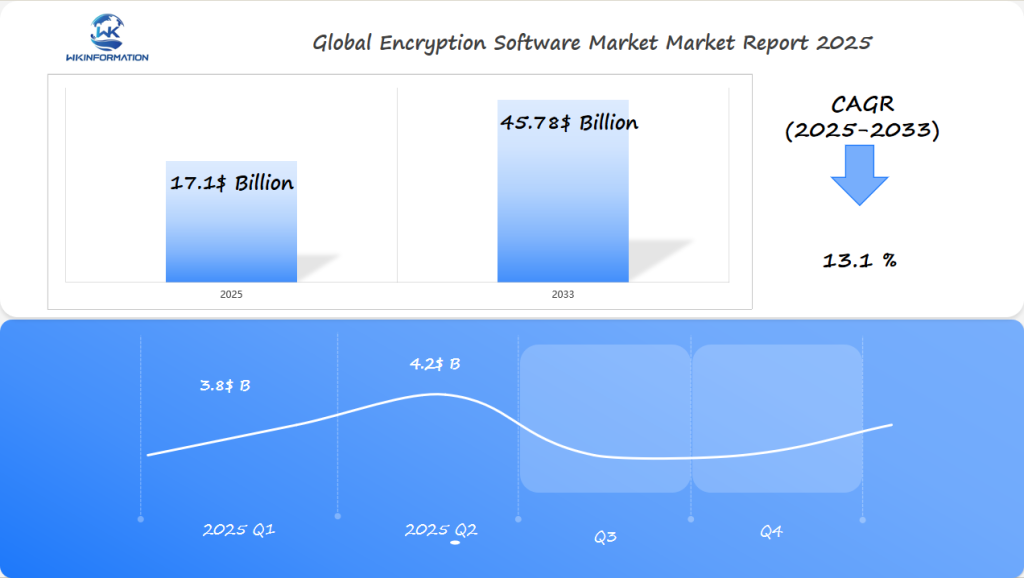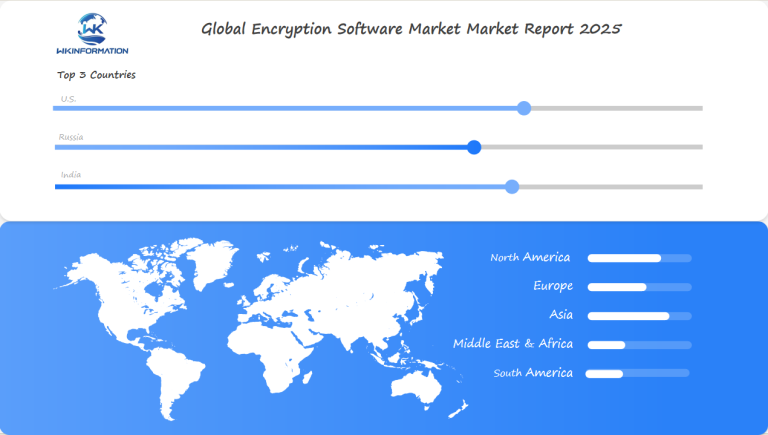Encryption Software Market Set to Reach $17.1 Billion by 2025: Key Insights from the U.S., Russia, and India
The Encryption Software Market continues to surge amid rising cybersecurity concerns, with major players like Microsoft and IBM leading innovations in data protection and compliance solutions.
- Last Updated:
Encryption Software Market Outlook for Q1 and Q2 of 2025
The Encryption Software market is projected to reach $17.1 billion by the end of 2025, with a CAGR of 13.1% from 2025 to 2033. In Q1 of 2025, the market is expected to be $3.8 billion, driven by increasing concerns over cybersecurity and data privacy regulations. By Q2, the market is forecast to grow to $4.2 billion, as businesses and governments around the world invest in encryption solutions to protect sensitive data from cyber threats.
The U.S. remains the largest market, with strong demand from sectors like finance, healthcare, and government. Russia and India are also seeing substantial growth due to increasing cyberattacks and the need for robust encryption solutions to secure both private and public sector data.

Key Takeaways
- Encryption software market projected to reach $17.1 billion by 2025
- Increasing cyber threats driving market expansion
- U.S., Russia, and India leading market development
- Digital transformation accelerating encryption technology adoption
- Cybersecurity becoming a critical global priority
Upstream and Downstream Dynamics in the Encryption Software Market
The encryption software market is a complex web of supply chain interactions. These interactions drive innovation and growth. Upstream components include raw material suppliers and hardware makers. They provide the basics for encryption technologies.
Key Players in the Supply Chain
Key players in the supply chain include:
- Semiconductor manufacturers developing specialized encryption chips
- Software developers creating advanced encryption algorithms
- Cloud service providers supporting digital infrastructure
- Cybersecurity research institutions
Downstream market dynamics are shaped by growing digital security needs. Organizations like financial institutions and government agencies need strong encryption. This is to protect sensitive data from cyber threats.
Factors Influencing Market Dynamics
The market dynamics of encryption technologies are influenced by:
- Evolving regulatory compliance requirements
- Growing cybersecurity awareness
- Rapid technological advancements
- Increasing global digital transformation
Strategic partnerships between hardware manufacturers, software developers, and end-users drive innovation in the encryption software ecosystem. These partnerships help create stronger and more flexible encryption solutions. They meet the complex security challenges of the digital world.
Trends Reshaping the Encryption Software Industry in 2025
The encryption software industry is undergoing rapid changes. New technologies are emerging to address complex digital security challenges, transforming the way we safeguard sensitive data across various sectors.
Key Trends Shaping the Future of Encryption Software
- Cloud Encryption: Businesses seeking robust data protection are increasingly relying on cloud encryption solutions. By leveraging advanced encryption techniques, organizations can secure their data stored in the cloud, effectively mitigating digital risks and countering cyber threats.
- Quantum Cryptography: This groundbreaking technology is gaining traction as a potential game-changer in the field of encryption. With its ability to provide unparalleled security against attacks from quantum computers, quantum cryptography holds immense promise for safeguarding sensitive information.
- AI-Powered Encryption: Artificial intelligence is being integrated into encryption solutions to enhance their effectiveness. By leveraging machine learning algorithms, these AI-powered systems can adapt and respond to evolving cyber risks, providing proactive defense mechanisms.
- End-to-End Encryption: Communication platforms are increasingly adopting end-to-end encryption as a standard practice. This ensures that only the intended recipients can access and decipher messages, protecting user privacy and preventing unauthorized interception.
Meeting Growing Cybersecurity Needs
As cybersecurity concerns continue to rise, there is a growing demand for user-friendly encryption solutions that strike a balance between security and usability. Both businesses and individual users are actively seeking encryption tools that offer seamless integration and robust protection without compromising convenience.
Evolving Challenges in the Digital Landscape
With the increasing complexity of digital ecosystems, it is imperative for encryption methods to evolve accordingly. Advanced cyber threats require equally sophisticated defense mechanisms, making it essential for encryption technologies to stay ahead of potential attacks.
As we move towards 2025, these trends will play a pivotal role in shaping the future of the encryption software industry. By embracing innovative approaches such as cloud encryption, quantum cryptography, AI-powered solutions, and end-to-end encryption, we can strengthen our defenses against evolving cyber threats and ensure the confidentiality of sensitive information.
Barriers to Growth in the Encryption Software Market
The encryption software market is facing big hurdles that slow its growth. These challenges make it hard for tech companies and businesses to protect their data well.
Regulatory Challenges
One big problem is the rules set by governments. These rules are strict and make it tough to use encryption in many areas. Companies struggle to create and use new encryption tech because of these rules.
- Complex government regulations limit encryption strength
- Export controls restrict global technology transfer
Technical Challenges
There are also technical issues that make encryption software hard to develop. Companies need to make security strong but also easy for users. Performance impacts and computational requirements add to the problem of getting more people to use encryption.
| Challenge Category | Primary Obstacles | Impact Level |
| Regulatory | Government Restrictions | High |
| Technical | Computing Power Requirements | Medium |
| User Experience | Complexity of Implementation | High |
To really make encryption software work, we need to tackle these challenges together. Tech companies, governments, and businesses must work together. This way, we can break down the barriers and move forward in protecting data.

Geopolitical Challenges Impacting the Encryption Software Industry
The encryption software industry faces many challenges. These come from international relations and data sovereignty. Governments around the world see encryption as key to national security. This makes it hard to develop policies and innovate in technology.
Some big challenges in the encryption market include:
- Escalating tensions between global superpowers regarding data protection standards
- Conflicting encryption policies across different international jurisdictions
- National security concerns driving restrictive technological regulations
Encryption policies are a big deal in international relations. Countries like the United States, Russia, and China are making new rules. These rules affect how encryption software is made. Data sovereignty is a big concern, as countries want to control digital information and keep their security safe.
Companies making encryption software have to be careful. They need to make solutions that work in many different places. They also need to keep security strong. It’s hard to make technology that fits many standards without losing security.
Emerging markets are very sensitive to these issues. Countries that are growing want encryption that respects their digital rights. They also want the latest security features.
Segmentation of the Encryption Software Market: Types and Technologies
The encryption software market keeps growing with new ways to protect digital data. It’s key for companies to know about different encryption methods for strong data safety.
Companies use many encryption technologies to keep their data safe. They need to protect data in different places and fields. The main encryption methods are:
- Symmetric encryption
- Asymmetric encryption
- Homomorphic encryption
Symmetric Encryption: Streamlined Data Protection
Symmetric encryption uses one key for both encrypting and decrypting. This method is fast and great for big data in closed systems. Banks and cloud services often use it to quickly protect sensitive info.
Asymmetric Encryption: Enhanced Security Mechanisms
Asymmetric encryption uses two keys: a public one for encrypting and a private one for decrypting. It makes data much harder to access by others. This is because of the complex math between the keys.
Homomorphic Encryption: Advanced Data Analysis
Homomorphic encryption is a new technology that allows you to analyze encrypted data without compromising its privacy. It’s ideal for researchers and businesses dealing with sensitive information. They can perform intricate operations while ensuring the data remains protected.
As cyber threats become more prevalent, companies must choose the appropriate encryption method for their data requirements.
Applications of Encryption Software in Data Protection and Cybersecurity
Encryption software is key in keeping digital data safe. It helps organizations protect their information from cyber threats. This ensures their digital assets are well-guarded.
Encryption adds layers of defense in today’s cybersecurity. It helps businesses keep:
- Financial transaction data
- Personal customer information
- Confidential corporate documents
- Communication channels
- Cloud storage systems
Different fields use encryption in their own ways. Healthcare organizations protect patient records. Financial institutions use strong encryption for money transactions.
Encryption software is vital in many areas:
| Industry | Encryption Use Case | Primary Protection Goal |
| Finance | Transaction Encryption | Secure Financial Data |
| Healthcare | Patient Record Protection | Maintain Privacy Compliance |
| Government | Communication Security | Prevent Information Breaches |
| Technology | Cloud Data Encryption | Protect Sensitive Infrastructure |
As cyber threats grow, encryption stays a top defense. Companies must keep updating their security to fight off new digital dangers.
Global Encryption Software Market: Regional Insights and Key Drivers
The global encryption software market is growing fast in many places. North America is leading, driving big growth thanks to its strong tech and focus on security.
There are many reasons why people are using more encryption. Each area has its own way of dealing with digital security:
- North America: Occupies the largest market share in the world
- Asia-Pacific: Is growing fast with new digital economies
- Europe: Has strong rules that help encryption tech grow
More and more companies are using encryption to keep their data safe. They know how important it is to protect against cyber threats. A big study shows 87% of companies want to spend more on encryption in 2024.
Every region has its own plan for using encryption software. Things like government rules, tech setup, and how aware people are of security play big roles.

The U.S. Encryption Software Market: Digital Security and Privacy Concerns
The US market for encryption software is growing fast. This is because digital security challenges keep getting worse. Companies in many fields are using strong encryption to keep their data safe from hackers and cyber attacks.
Impact of Privacy Laws on Encryption
Privacy laws have changed how encryption works in the US. Laws like the California Consumer Privacy Act (CCPA) and HIPAA make companies use better encryption. This is to protect people’s personal information.
- Healthcare sector requires strict data protection mechanisms
- Financial institutions invest heavily in advanced encryption solutions
- Technology companies develop cutting-edge encryption algorithms
Role of Government Agencies in Encryption Standards
Government agencies help set encryption standards. The National Institute of Standards and Technology (NIST) gives guidelines. These guidelines help both public and private sectors use encryption correctly.
Ongoing Debate: Encryption Backdoors
The debate over encryption backdoors is ongoing. Privacy groups and law enforcement have different views. Companies must find a balance between keeping data safe and following the law.
Growing Complexity of Cyber Threats
Cyber threats are getting more complex. This means the US will need more advanced encryption software. This will lead to more innovation and investment in digital security.
Russia's Influence on Encryption Software: Regulatory Landscape and Adoption
The Russian market for encryption software is complex. It’s shaped by strict government rules. Data localization laws have changed how tech companies work in the country’s digital world.
Impact of Russian Encryption Laws
Russian encryption laws have a big impact on digital security. They affect both local and international software providers. The government sets strict rules for encryption technologies, including:
- Mandatory registration of encryption software
- Potential requirement to provide decryption keys to authorities
- Restrictions on foreign encryption technologies
Encryption laws in Russia pose big challenges for international tech companies. Local businesses must navigate a challenging regulatory environment. This environment focuses on national security over global digital privacy standards.
Effects of Data Localization Rules
Data localization rules force tech firms to store Russian user data locally. This has caused tension between government control and tech innovation. Many companies are now creating special encryption solutions for the Russian market.
Key technological responses include:
- Development of Russia-specific encryption platforms
- Creation of localized secure communication tools
- Enhanced collaboration between government and tech sectors
The Russian encryption software market is a key area for innovation. It’s influenced by changing geopolitical tensions.
India's Role in the Encryption Software Market: Growing Digital Infrastructure
India’s digital transformation is changing the encryption software world. The Indian market is now a key player in global cybersecurity. It’s driving innovation and advancements in encryption solutions.
India’s digital growth is pushing encryption startups to the top of tech innovation. The Digital India initiative has opened up big opportunities for cybersecurity investments. This is especially true in important sectors.
- Finance sector encryption adoption increased by 35% in 2023
- Healthcare digital security investments expanding rapidly
- E-commerce platforms prioritizing advanced encryption technologies
Encryption startups in India are creating advanced solutions for digital security challenges. Bangalore and Hyderabad are major centers for cybersecurity innovation. They’re attracting a lot of venture capital investments.
India’s approach to digital transformation includes strong policies for encryption technology. Government regulations help encryption software companies grow and compete worldwide.
Technologies like artificial intelligence and blockchain are speeding up encryption solution growth in India. This makes India a big player in the global digital security scene.
Future Trends in Encryption Software and Cybersecurity
The world of encryption is changing fast, thanks to new tech. Experts are working hard to keep our digital world safe from new threats. Network encryption markets are seeing big changes, especially in new encryption types.
Here are some big changes in encryption software:
- Post-quantum encryption algorithms designed to resist quantum computing attacks
- Advanced IoT security protocols for interconnected devices
- Homomorphic encryption enabling secure data computation
- AI-powered threat detection mechanisms
IoT security is a big challenge for encryption. Devices need light, fast encryption to keep data safe without slowing down. Researchers are finding new ways to protect IoT devices with future encryption.
Quantum computing is changing how we encrypt data. New encryption methods are being made to protect against quantum attacks. These methods aim to keep our important data and messages safe.
Companies are spending more on the latest encryption to stay safe online. They’re using AI, machine learning, and new encryption to keep their networks secure.
Competitive Insights in the Encryption Software Market
The encryption software market is very competitive. Top companies and new players are fighting for the lead. They use smart strategies and the latest technology to protect data.
Key Players:
-
Symantec (Broadcom) – United States
-
Google – United States
-
IBM – United States
-
Microsoft – United States
-
Trend Micro – Japan
-
Sophos – United Kingdom
-
Thales Group – France
-
Check Point Software Technologies – Israel
-
Dell Technologies – United States
-
ESET – Slovakia
Strategies of Leading Companies
Big names in the encryption world are standing out with their unique security methods. They are using different tactics to stay ahead:
- Creating advanced encryption algorithms
- Building easy-to-use security tools
- Using artificial intelligence to find threats
- Protecting data across all devices
Disruption by Startups and Open-source Projects
New startups are shaking things up with innovative encryption technologies. Open-source projects are also making data protection more accessible to everyone.
Market Trends and Predictions
Recent deals show the market is getting smaller as companies grow bigger. The ones who offer complete, flexible, and easy-to-use solutions will likely lead the market soon.
Overall
| Report Metric | Details |
|---|---|
| Report Name | Global Encryption Software Market Report |
| Base Year | 2024 |
| Segment by Type |
· Symmetric Encryption · Asymmetric Encryption · Homomorphic Encryption |
| Segment by Application |
· Finance · Healthcare · Government · Technology · Others |
| Geographies Covered |
· North America (United States, Canada) · Europe (Germany, France, UK, Italy, Russia) · Asia-Pacific (China, Japan, South Korea, Taiwan) · Southeast Asia (India) · Latin America (Mexico, Brazil) |
| Forecast units | USD million in value |
| Report coverage | Revenue and volume forecast, company share, competitive landscape, growth factors and trends |
The encryption software market is at a key moment, set to grow to $17.1 billion by 2025. This growth shows how important data protection is in our digital world. Cybersecurity experts see encryption as a key defense against new digital threats.
Big tech names like Microsoft, IBM, and Google are leading in encryption tech. They’re pushing for better ways to protect our digital world. Companies are looking for encryption that works well and keeps threats at bay.
Working together is key for a safer digital future. Governments, tech companies, and cybersecurity experts must team up. Places like the U.S., Russia, and India are making rules to help encryption grow. These efforts will help keep our digital world safe from threats.
Encryption will keep being a big part of keeping our digital world safe. Companies need to keep investing in new encryption tech. The next ten years will see big changes in how we protect our digital lives and keep our privacy safe.
Global Encryption Software Market Report (Can Read by Free sample) – Table of Contents
Chapter 1: Encryption Software Market Analysis Overview
- Competitive Forces Analysis (Porter’s Five Forces)
- Strategic Growth Assessment (Ansoff Matrix)
- Industry Value Chain Insights
- Regional Trends and Key Market Drivers
- Encryption Software Market Segmentation Overview
Chapter 2: Competitive Landscape
- Global Encryption Software Players and Regional Insights
- Key Players and Market Share Analysis
- Sales Trends of Leading Companies
- Year-on-Year Performance Insights
- Competitive Strategies and Market Positioning
- Key Differentiators and Strategic Moves
Chapter 3: Encryption Software Market Segmentation Analysis
- Key Data and Visual Insights
- Trends, Growth Rates, and Drivers
- Segment Dynamics and Insights
- Detailed Market Analysis by Segment
Chapter 4: Regional Market Performance
- Consumer Trends by Region
- Historical Data and Growth Forecasts
- Regional Growth Factors
- Economic, Demographic, and Technological Impacts
- Challenges and Opportunities in Key Regions
- Regional Trends and Market Shifts
- Key Cities and High-Demand Areas
Chapter 5: Encryption Software Emerging and Untapped Markets
- Growth Potential in Secondary Regions
- Trends, Challenges, and Opportunities
Chapter 6: Product and Application Segmentation
- Product Types and Innovation Trends
- Application-Based Market Insights
Chapter 7: Encryption Software Consumer Insights
- Demographics and Buying Behaviors
- TargetAudience Profiles
Chapter 8: Key Findings and Recommendations
- Summary of Encryption Software Market Insights
- Actionable Recommendations for Stakeholders

Access the study in MULTIPLEFORMATS
Didn’t find what you’re looking for?
TALK TO OUR ANALYST TEAM
Need something within your budget?
NO WORRIES! WE GOT YOU COVERED!
Call us on: +1-866-739-3133
Email: infor@wkinformation.com


